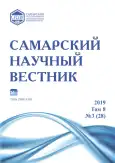Организация словарно-семантической работы в начальной школе на основе определения словаря зон агнонимического риска
- Авторы: Авдонина А.Ю.1
-
Учреждения:
- Самарский филиал Московского городского педагогического университета
- Выпуск: Том 8, № 3 (2019)
- Страницы: 248-250
- Раздел: Педагогические науки
- URL: https://journals.rcsi.science/2309-4370/article/view/34383
- DOI: https://doi.org/10.17816/snv201983301
- ID: 34383
Цитировать
Полный текст
Аннотация
В данной статье рассматривается актуальная проблема организации словарно-семантической работы в начальной школе. Существующие традиционные подходы, к сожалению, не выходят за рамки методики преподавания русского языка, не способствуют формированию целостного культурно-речевого пространства, обеспечивающего успешное овладение знаниями по изучаемым предметам и достижение целей коммуникации. Школьная практика показывает, что одной из основных причин, негативно влияющих на качество продуцирования, восприятия и понимания текстов, является агнонимия, которая имеет непосредственную связь с периферийными пластами лексики. В основном это архаизмы, историзмы, устаревшая лексика, научные термины, а также слова и выражения, которые мало понятны ребенку и не употребляются им в повседневной жизни. Они нередко встречаются в учебниках, затрудняют восприятие и продуцирование текстов. Используя предложенные в статье типы заданий, учитель сможет самостоятельно подобрать конкретный дидактический материл (в соответствии с учебниками УМК, по которому обучаются дети), на основе которого и будет определяться словарь зон агнонимического риска обучающихся, охватывающий все предметные области по годам обучения. Такая организация словарно-семантической работы, в первую очередь, обеспечит эффективное формирование общей культурно-речевой среды, а также глубокое понимание текстового дидактического материала по всем школьным предметам и станет залогом успешной коммуникации.
Ключевые слова
Полный текст
Открыть статью на сайте журналаОб авторах
Анна Юрьевна Авдонина
Самарский филиал Московского городского педагогического университета
Автор, ответственный за переписку.
Email: avdonina1911@yandex.ru
кандидат педагогических наук, доцент кафедры педагогики
Россия, СамараСписок литературы
- Авдонина А.Ю. Основы методики развития речи учащихся: учебно-методическое пособие; Министерство образования и науки РФ; ГОУВПО «Самар. гос. пед. ун-т». Самара: Самар. отделение Литфонда, 2009. С. 49–50.
- Львов М.Р. Основы теории речи: учеб. пособие для студ. высш. пед. учеб. заведений. М.: Издательский центр «Академия», 2002. 248 с.
- Жинкин Н.И. Язык. Речь. Творчество. Избр. тр. М.: Лабиринт, 1998. 368 с.
- Соловейчик М.С., Жедек П.С., Светловская Н.Н., Цукерман Г.А., Горецкий В.Г., Кубасова О.В. и др. Русский язык в начальных классах. Теория и практика обучения. М.: Академия, 1997. 383 с.
- Занков В.В. Психология понимания: проблемы и перспективы. М.: Институт психологии РАН, 2005. 448 с.
- Фомичева Г.А. Работа над словосочетанием и предложением в начальных классах: пособие для учителя. М.: Просвещение, 1981. 159 с.
- Левушкина О.Н. Словарная работа в начальных классах: пособ. для учителя. М.: ВЛАДОС, 2002. 95 с.
- Антонова Е.С., Боброва С.В. Методика преподавания русского языка (начальные классы). М.: Академия, 2015. 456 с.
- Выготский Л.С. Мышление и речь. М.: Изд-во «Лабиринт», 1999. 352 с.
- Морковкин В.В., Морковкина А.В. Русские агнонимы (слова, которые мы не знаем). М.: Ин-т рус. яз. им. Виноградова, 1997. 414 с.
- Савина Е.О. Диалектная лексика в романе Л.Н. Толстого «Война и мир» // Материалы к словарю тульских говоров: язык, история, традиции: сб. науч. ст. / Под общ. ред. Д.А. Романова, Н.А. Красовской. Тула: Изд-во ТГПУ им. Л.Н. Толстого, 2014. С. 65–70.
- Авдонина А.Ю. Организация работы с текстом на уроках русского язык: учебно-методическое пособие. Самара: СИПКРО, 2016. 138 с.
Дополнительные файлы






